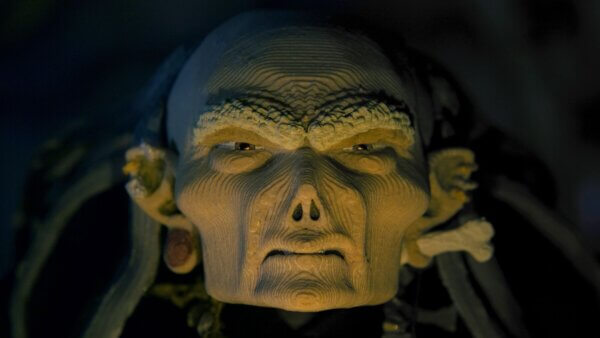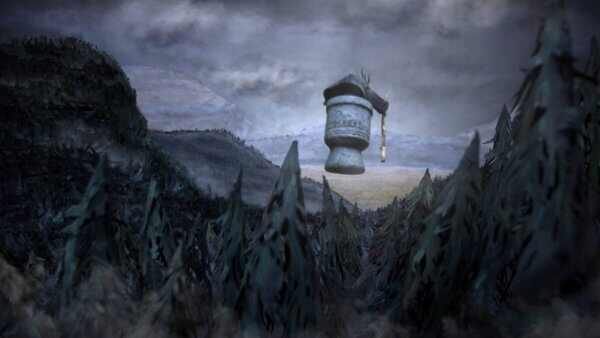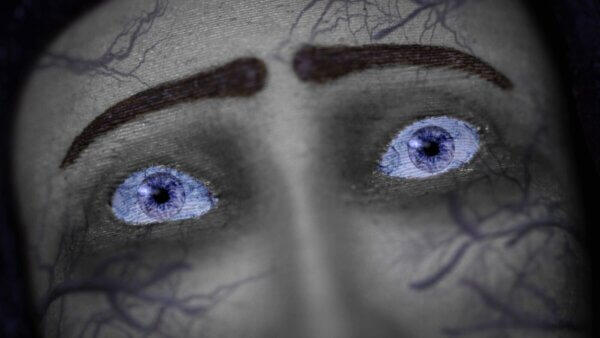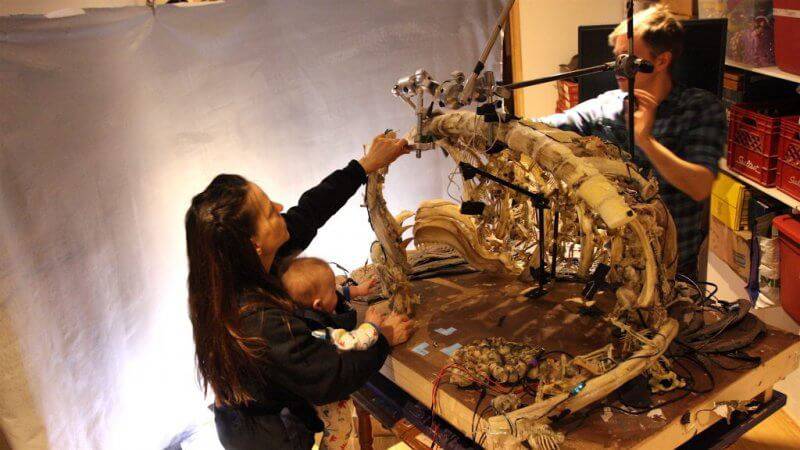Interview with Dale Hayward and Sylvia Trouvé (Bone Mother)
In a shadowy wood, full of unusual trees and the skulls of fallen men, lies the house of a wise creature known to some as the Bone Mother – or Baba Yaga, to many more. The creators of this eerie world are the directorial duo of Dale Hayward and Sylvia Trouvé. In association with the National Film Board of Canada, the highly skilled and experienced co-directors have brought together an ancient, folkloric tale with classic stop-motion sensibilities and novel digital fabrication techniques, to bring to the audience a dark and highly crafted short film. After meeting on commercial stop-motion production in Toronto the creative couple moved to Montreal Canada to seek out a more independent venture in order to make there won work. They now split there tie between there own personal work though there studio See Creature Animation and working on other peoples film, commercial production and feature film such as The Little Prince (2016).
After spending the last few years following the film’s social media pages, watching the team developed the unique visual design, harnessing new and innovative materials using 3D Printing to develop unusual textural profiles that are applied both the puppets, props and the scenery in a film that is as modern in technique as it is ancient in appearance. We took a deep dive into all things animated, and pick over the details that made this fascinating new film.
What circumstances led to you making the film in the first place?
Dale Hayward (DH): Originally I heard the story it was originally based on, on a horror podcast a short story podcast called PseudoPod, the original story is written by Maureen McHugh an Irish author. It was just really fascinating story I was really drawn into how she took Baba Yaga, I vaguely knew who baba was, but then upon that I researched her more and saw what a diverse character Baba Yaga is, there are so many stories of her and not very familiar with her in North America.
Sylvia Trouvé (ST): The writing was so nicely textured and visceral that we really felt it would be a good story for stop-motion between the characters and they way it was written. It was so visual. Then Michael Fukushima, who is now the exec producer at the NFB asked Dale whilst we were working on another project if he had any films he had to pitch him and he said yeah I do I’ve got one but it’s not quite for the NFB he said well pitch it for me anyway there where it started, and he liked the film and went into adapting the story for film.
Why didn’t you think it wasn’t necessarily a fit for NFB?
DH: Because I knew it was more commercial in general as far as the characters are kind of pop-culture especially vampires are definitely prevalent today in pop-culture, witches as well but I think the archetypes and the kind of story it was telling was also a bit commercial and we wanted, and the story felt like it was, so the story we told, in this, was more of a commercial idea, story structure…
ST: …The layout. the dialogue. We’ve done a lot of films without dialogue, and more abstracted way narratives that leave the audience kind of trying to put their own interpretation to things, and trying to figure things out, where ours pretty much tells you – it’s what you’d call a folkloric tale and it’s just different to what they usually do. Trust me it took us a long time to get there, we had way too many ideas to fit in a short film. So we had to change the story quite a bit in order to adapt it to fit in that time frame. But it was a really interesting, and challenging and educational experience.

Bone Mother (image via NFB)
The production went on for quite a while, didn’t it?
ST: It took over four years, but we did have a baby at the same time, so it slowed down things a little, even though we didn’t take that much time off, we got right back into it like a month after the baby was born.
DH: That was one of the reasons why we moved, we were set up at the film board with a big space and everything but then we moved everything into our little studio basement, because of the baby here and it made it, it definitely added a level of complication but it made it possible as well and made us experience our son possible as well, well making the film
ST: For both of us to still be able to be involved in the film, otherwise if we hadn’t done that then probably Dale would have done the film by himself at the film board, not a nice life.
DH: Yes she needs to be tortured by the film as well (laughing).
The overall look and feel of the film is stunning, where did you gather your inspiration from for the film?
DH: Mike Mignola from hell boy a lot, we really looked at early turn of century illustrations by Ivan Bilibin he did these beautiful still images children’s book illustrations, where Mike Mignola is the idea of complex silhouettes so you get all this detail but there’s no detail inside of it so we always kinda felt we like the silhouettes of things
ST: The trees were cutouts that were that came from.
DH: Even Baba is just this balck mass sometimes hands just stick out like Egon Schiele as well, definitely live action films as well influence, I think that what’s nice in stop-motion is a bridge between animation and live action, so natural lighting was a big thing we were looking at a lot of examples of just lighting you know just natural of tiem of the period it was really early morning and gloomy so it was really tough ot light that so it felt more natural and live action, so, but other visuals what Laika is doing with there productions and raising the value as far as the detail in facial expressions it’s a lot more realistic aesthetic then we have done in the past and so because of the range of facial expressions we wanted to get that kind of lead the asphetic to be a little more detailed the visual effect were a bit more realistic more detailed because you know you bring up this aesthetic you’ve got to keep it all at the same level so it’s interesting how the project overall look evolves during the production
The film has this very hand-rendered feel to it but obviously, you use a lot of modern technology in it, was it the Laika influence that sort of brought that about, or are there other reasons?
DH: It was definitely that we were encouraged by that but we knew that we could afford printers to that level. But you know I was already looking researching a lot for when we were gearing up for the stop-motion sequence in the Little Prince we pitched that to them at one point and they wanted to go a lot more of a handmade aesthetic, and at that time was feeling very techno-based so when we started to play with it in are R and D time we discover that if we printed Baba’s face lying down you go this sedimentary feeling and we could naturally, through technology get these wrinkles.
ST: Through this lack of expertise of the printer in a way, it makes it feel natural too.
DH: Yeah through the limitation of the printer, we made an intention with her face, it gave it a handmade feel to know at least it was still stop-motion
ST: We wanted to do the 3D printed faces we wanted to have a range of expressions we wanted to play with their animation of the face itself in terms of the forehead and cheeks to going up when you squint there’s so much movement in your face you can’t do in stop-motion when you have two little eyes and a replacement mouth were always feeling limited by that so that was like finally 3D printers lets try and see how much we can get out of to be able to convey more emotion because we knew are films had so many, such a variety of emotion in it.

Bone Mother (image via NFB)
Also because of the way you did it, it holds onto that kind of stop-mo aesthetic and it is also not overly complex were sometimes because some films have millions and millions it kind of a bit you manage to steer away from what some people do with that kind of technology that it kind of takes away?
DH: Yeah, I think setting limits, we also in retrospect could have gone back and limited our rangers even further because of the quality limitation on the printer there was some face on Maya that looked like there was a big difference between but in reality, you couldn’t tell the difference. So because there all hand-painted as well, that gave them a bit more of a boil, .which was nice we wanted to embrace that, we wanted it.
ST: It made them feel more alive.
DH: Even for Vlad we tried to keep it smooth but there’s still a little texture to him as well, I think it’s nice, it gives him this extra movement to them.
This refers back to the initial influences you had, of the hand-rendered, almost etching aesthetic.
DH: Yeah, we even used it for all the skulls and skeletons and the house. That was what was nice about the 3D printers, it allowed us to get a large production look with a small team. At max, it was five of us but most of the time it was just Sylvia and me. It allowed us to have two different scales of the house, tons of bones and tons of modelling which was just so we don’t have to worry about moulds or anything like that.
Did you do the modelling yourself or did you bring in someone to do that?
DH: Yeah, we had a few other people in to do that, Andre Michaud, who guided us in the 3D printing and then the Maya and he also made our puppet armatures too. We did a lot of prototyping trying out different styles.
ST: It was nice to have someone who knew that already, so we didn’t have to learn that as well. We had too much stuff we had to learn already. That was one thing that we were like ok let’s find someone.
Were the armatures 3D printed or were they traditionally made?
DH: They’re traditional, we prototyped some in 3D printing. Originally the film was a lot flatter we kinda wanted to do moving illustration but it felt a little too Lotte Reiniger. The faces were a little bas-relief and then we were like Christ! we will have to do rotations we have to 3D print that rotation. Ok forget it but we did prototype that. We also printed the chest blocks and their pelvis padding around legs and the arms all of that was 3D printed as well all the muscle so to speak. It was nice to just kind of play with the 3D printing also we found if we heated it up with a heat gun we can shape it so we also shaped Baba’s hunch and tried to shape her as we were going.
ST: We also animated the hands that way because they were 3D printed as well. So it’s amazing what you can get away with, with one hand position you wouldn’t think it but you can, just by rotating the wrist it gives a twirling impression of the hand.
I think that was the other nice thing that I saw in your blog posts on Instagram, you didn’t treat 3D printed objects as if they were these precious final things. You burnt them, melted them and they are kind of thrown away or used up, which was quite nice because in stop-motion you’re more used to that. You also used quite different materials as well, such as wood-based filament.
DH: The wood filament was for the face and hands, the hair was a flexible filament, in our model we put little trenches for wire in, so we use this wood burner or soldering iron to melt these thin printed sheet of plastic and hold the wire and do a sort of seeming.
ST: The bones were made out of clear plastic.
DH: Which allowed the light to shine through. We wanted to try lots of things there like a there’s magnetic filament as well, it’s like an endless pit of coolness in 3D printing.
ST: It took us a while before we found the wood one and we were really excited. We had tried painting on all the different plastic ones and it always just looked like plastic, it just didn’t look nice you know and it didn’t fit the story. She was in the woods and she was this mother of nature so when we found the wood filament it felt more natural and it took watercolour paints so well.
DH: It’s a little porous which is really nice and we knew we had a lot of faces so we couldn’t do much Refinishing to them it felt like other 3D printing you could tell they have a limited mouth set of like 20 and they’d really sanded them down but we were going to have like hundreds so we couldn’t do that most of the time especially for Baba, that’s how she looks out of the printer, we just did like a wash on her and that was on top but didn’t sand it, Vlad Need a little bit more clean up mainly around the mouth but as little clean up after the print was done which was great.
ST: The 3D printing was really ideal because we wanted her to feel so wrinkly and with a traditional mould that would be really difficult to do to that extent. Also, she felt kind of topographical, in the woods and ancient. This new technology seemed to fit so well to this old story that was set in the 15th century which was really amazing.
DH: It is nice as well to see it being in a more worthwhile way and not just as a gimmick as with other short-form production. I think you are one of the first films, that I know of that have used the technology for a legitimate reason other than because it is modern or a statement on old and new technology clashing and what that means. It’s nice to see it being used effectively and usefully. You have both previously worked together as you said previously on ‘The Little Prince’ and ‘If I was God’,is that how you met or did you meet a long time ago?
ST: We met a long time ago we met in Toronto when we used to work together at a commercial studio, we animated day in day out on stop motion, for like 5 years before we moved to Montreal and did the Hothouse programme at the NFB.
DH: We kind of got a start cut-out teeth in TV series it was a good way of going through the ranks and trial all sides of production. Then when we came to Montreal to join the independent filmmaking world. We kept our contacts in Toronto so we could do Commercial work but we started doing our own independent work as soon as we came here which was in 2007.
ST: It’s really thanks to the National Film Board that we decided to go into filmmaking instead of just working in a commercial studio because the Hothouse programme really gave us a taste for what you know making Fields as all about and they’re now we love Montreal so much we decided to stay here.
DH: We’ve worked independently but we mainly work together with our company Sea Creature and then also alongside each other at different places like ‘The Little Prince’ doing large scale motion graphics at Moment Factory.
ST: Every project is completely different, you’re working on a documentary or working on a commercial or you’re working on somebody else’s film for feature Productions. It’s all great, that everything is different keeps challenging yourself and trying to learn new things and you keep realising there’s so much more to learn.
How have you found the initial response to the film?
ST: It’s pretty cool for the people that like this kind of film. Some people are not into folklore or the genre. Like with everything in life for those who like it, they seem to really like it. It’s been nice
DH: It’s been really interesting on social media through Instagram, meeting this great new community of occult, witch, folklore people and it’s really great to be accepted into that different community.
ST: It’s great to have a community behind you to encourage you and some days you ask yourself what the hell am I doing? who am I doing this for? and then it’s so nice to have other people liking your work because it’s hard to like it yourself sometimes so you need that.
DH: That’s why we were big on sharing what we were doing during the production right from the beginning it’s something I’ve been trying to encourage the film board to do. Luckily they’ve been more open to it because that was something the community, especially in animation which is what we are, a community. To find this new community, that’s also really interested in this sort of thing that wouldn’t normally have contact with animation for whatever reason. So it’s nice to bridge that and expose another community to animation and another way of encouraging us too, so it’s not just us in our own little bubble.
ST: Especially when you’re working in a basement
DH: That bubble’s really small.

Bone Mother (image via NFB)
That’s the nice thing about working in what could be perceived as a niche, such as animation it’s a nice niche and stop-motion within that is another niche and the horror even more so. The more niche you go the more involved the audience gets.
DH: Yeah that’s kind of the way we’ve been approaching the festivals as well is more this is what I need is this is the first brand and finding that and I think that’s really important to gauge whether something is Successful or not because you’re fit in a tank in a market that this isn’t really the kind of thing it’s not really a true indicator of the quality of the project so it helps to identify what your project is and it’s been the case of all the other things we’ve worked on which is a full variety so this one just happens to be that puppet horror thing the next one is a comedy so totally different.
Do you think the NFB is quite good at finding those festivals, audiences, people to direct to a more natural fit?
DH: Totaly, they’re becoming more and more open to it. They have their path that has been successful for some films but most don’t follow that path. So that’s why we’ve been encouraging them to open their minds to where they can screen it. I think it’s also why the film has been released online at the start of its entry into festivals.
ST: For everyone too, as initially it was only meant to be open for the comedian audience, then we were like no, (laugh) everyone’s gotta see this on Halloween. A lot of the time you make a film and go around to festivals for a year or two and then nobody gets to see it, but for us, it was really important for it to go online because then everyone that’s been following it as well, I mean it’s done now and if you wait two years until you show it they might forget about it you know, so I think it’s hot off the press and you just got to give it access to people that might not be going to film festivals too right.
You can see behind the scene content for the film on Instagram account here. Or watch the film in full on the National Film Board of Canada website here.
Hear the audio interview with Dale and Sylvie in episode 86 of the Skwigly Animation Podcast (Direct download or listen below):


